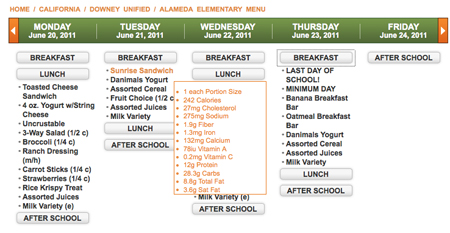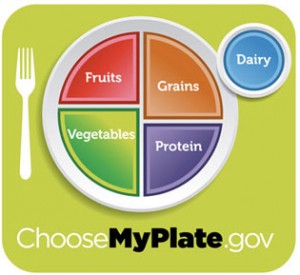The father-son team of Frank and Craig Kohler at SchoolMenu.com is taking a stance against childhood obesity, making themselves an active player in doing something for children throughout the U.S. and giving parents the tools to in turn empower themselves. 
The Kohlers created SchoolMenu.com almost by accident. Frank led the charge on turning the side of milk cartons in to an ad medium in schools 20 years ago, working with Warner Brothers to share kid-friendly messages like saving the environment. That led to learning about the multi-million dollar business that is school food service, and thus begun their school menu service 15 years ago. They had an audience of four million elementary school children who received their “Tooned-In” school menu each month, which in addition to the menu included nutritional games, puzzles, and advertisements from the entertainment industry (for instance Shrek or Harry Potter). Then to complement the printed menu, Craig Kohler tells us that they created the dot-com part of the business as an “ancillary site that was kid-focused with games and puzzles.”
It’s only recently that they stopped printing the menus and started publishing them exclusively online at SchoolMenu.com, a move Craig says was due to “a combination of the decline in print advertising and the increased cost of printing and shipping.” He also adds that the site moved away from being kid-centric and instead more focused on meeting the needs of moms.
Simply put, SchoolMenu.com is a free online resource for schools and parents to share and have as much information about the cafeteria menu as possible. Schools can publish their menus on SchoolMenu.com, and parents can view the menus and their related nutritional information, all at no cost.
Frank indicated that this multi-million dollar business of running school cafeterias should be viewed as just that, a business. “They are set up to operate like any other restaurant chain,” he says. “School cafeterias are the only for-profit center in the district.” Run as independent entities, each school has their own food services director; a person, Frank notes, that few parents are familiar with and all should make a point of becoming so. This director oversees every detail of the food service within their district, and isn’t unlike a CEO of a restaurant chain.

Frank and his account management team work closely with these food service directors to publish their menus on SchoolMenu.com, a service that offers many benefits to the schools and those they serve. There are no costs to be involved; in fact, Frank shared examples of where it actually saved districts money.
“In one major district, they no longer have a web department to manage the publishing of the school menus,” he says. By switching to SchoolMenu.com, that district saved $100,000 per year. This is because the Kohlers’ site publishes the menus for them, and gives each school, not just the district, its own unique URL so that parents can view the menus online without any cost to the school’s budget. Simply bookmark and check back as often as you need.
Another cost-saving benefit of the service is that schools no longer have to print hundreds and thousands of paper menus to send home to students each month, a cost that can be as much as 10 cents per sheet. Parents can access the menu online and, should they need a hard copy for themselves, print it from their home computers.
“It’s a state-of-the-art site that empowers parents and educators,” says Frank.
While the benefits to the schools primarily impact their bottom lines, the benefits to parents are powerful as well. According to the American Dietetic Association, millions of moms are looking for more than just the items on the menu, but the nutrition information too. According to the ADA, 60 percent of moms say they don’t trust the information they find online because they feel the sources are commercial. Frank clarifies that “there’s nothing commercial about us, just common sense health.” He also makes note that “all of the articles posted [on SchoolMenu.com] come from reliable non-commercial sources like Tuft’s University, Baylor University School of Nutrition and from the special Schoolmenu.com doctors and nutritionists.”
Every month a growing list of more than 130 school districts send their menus to SchoolMenu.com, where the customer service team format the menus, incorporate the nutritional information for each item provided by the school’s food service department, and then post it. According to Frank, “it absolutely meets the standards set by the USDA,” for school food services.
 Currently the districts looking for federal meal reimbursement must adhere to the guidelines set forth in the National School Lunch Program, which was founded under President Truman’s administration as a way to ensure draft-eligible young men were getting the nutrients they needed to be strong and healthy enough to join the military. I had to ask Frank if this were really the case. In my personal experience of attending a public school lunch on a regular basis with a young girl that I mentor, not to mention when I was a kid, I expressed my disdain for the “Uncrustables” frozen PB&Js, batter-dipped corn dogs, grease-laden pizza, and syrup-slathered “fruit”. Frank’s enthusiasm for my concern for what our children are being fed was palpable, and his response enlightening.
Currently the districts looking for federal meal reimbursement must adhere to the guidelines set forth in the National School Lunch Program, which was founded under President Truman’s administration as a way to ensure draft-eligible young men were getting the nutrients they needed to be strong and healthy enough to join the military. I had to ask Frank if this were really the case. In my personal experience of attending a public school lunch on a regular basis with a young girl that I mentor, not to mention when I was a kid, I expressed my disdain for the “Uncrustables” frozen PB&Js, batter-dipped corn dogs, grease-laden pizza, and syrup-slathered “fruit”. Frank’s enthusiasm for my concern for what our children are being fed was palpable, and his response enlightening.
“If the school is participating in the USDA approved National School Lunch Program and is getting reimbursed from the government for feeding kids that qualify for a free lunch, it is meeting current nutritional guidelines,” he told me.
He indicated that they always find a way to meet the guidelines; for instance, the corn dogs likely are made with turkey, are low fat and have a whole grain batter. The pizza is most likely made from whole grain, low fat cheese and healthy vegetables. Not where I’d like to see whole grains being served, but it’s better than nothing… right?
Exactly what are these guidelines? The USDA explains in this document for the National School Lunch Act.
“Participating schools must serve lunches that are consistent with the applicable recommendations of the most recent Dietary Guidelines for Americans including: eat a variety of foods; choose a diet with plenty of grain products, vegetables and fruits; choose a diet moderate in sugars and salt; and choose a diet with 30% or less of calories from fat and less than 10% of calories from saturated fat. In addition, lunches must provide, on average over each school week, at least 1/3 of the daily Recommended Dietary Allowances for protein, iron, calcium, and vitamins A and C.”
In June 2025, the USDA in partnership with Mrs. Obama announced the replacement of MyPyramid with MyPlate. Frank said the new guidelines will be reflected in the meals being served over time as it will be a continuing work in progress.
 Schools that do not meet these guidelines as participants in the National School Lunch Program risk losing their financial reimbursements. Frank cited the average school lunch cost at $1.25-$3 per student, and the government reimburses $2.74 for a student on free lunch (below the poverty level), about 40 cents less for students on reduced lunches, and zero for students who pay full price.
Schools that do not meet these guidelines as participants in the National School Lunch Program risk losing their financial reimbursements. Frank cited the average school lunch cost at $1.25-$3 per student, and the government reimburses $2.74 for a student on free lunch (below the poverty level), about 40 cents less for students on reduced lunches, and zero for students who pay full price.
So if schools already have this nutritional information available to them, because of the regulations they must meet, then it should, ideally, be readily available to parents. That is rarely the case. In fact, Frank says in districts where school menus are published on the schools’ sites, it is often impossible to find, and no information outside of the scheduled menu itself is available. That again, is where Frank’s team at SchoolMenu.com comes in.
Very simply, from the SchoolMenu.com site all you do is hover your mouse over a specific food item listed on the menu, and a window appears detailing every calorie, gram of fat, milligram of sodium, and other nutritionals that you’d find on any packaged food. The only thing missing is an ingredient list, which Craig explains isn’t something they’re currently set up to provide, but looking into.
Now that parents are armed with this information, “They can use it to teach their children about healthy nutrition by reviewing menu choices and discussing and incorporating similar foods into their menus at home,” notes Dr. Melina Jampolis. “They can also make sure that their children are being served healthy options that they like!”
Dr. Jampolis is the most recent addition to the SchoolMenu.com team of experts, something she took on because “I am very committed to fighting childhood obesity and there is no question that this requires extensive involvement by the family. My goal is to provide tools to empower families to accomplish these goals and SchoolMenu.com is a fundamental tool,” she tells us. Dr. Jampolis is an internist, one of only a few hundred board certified physician nutrition specialists, and author of “The No-Time-to-Lose Diet.” 
She’s not the lone expert at SchoolMenu.com, though. They have an impressive team of doctors and dietitians who serve on an advisory board and share articles that help round-out the free information available to parents on the site. Other notable names on the site’s staff include Dr. Keith Ayoob, Director of Nutrition at Einstein College of Medicine in New York; Sylvia Melendez, MS, RD, LDN, CPT; Tracey Mallett, CPT and star of her own self-titled fitness DVDs; Maryann Jacobsen, MS, RD who specializes in child nutrition; and Drs. Yolanda Evans and David Breland, who specialize in adolescent health and obesity.
The one thing you can’t do at SchoolMenu.com, that they want you to do, is “Speak to the food services director at your school,” advises Frank. “School food service directors are especially dedicated individuals and they believe they are serving a real purpose by serving America’s kids.” 
Frank notes that most parents don’t have any idea who this person is, nor do they realize that most school districts have an RD (registered dietitian) on staff as well. “They are advocates for change and they want to know how they can do better, as they continually strive to improve the quality of the food they serve.” Frank recommends that parents get to know their district’s food service director and in these meetings, ask questions, offer constructive advice and feedback, and even learn what you can do to help.
Frank explains that most often these directors and dietitians are well credentialed, an attribute he says has risen dramatically in recent years. “They have PhDs, MBAs, RDs, and the like.”
What’s next for SchoolMenu.com is to continue to grow its presence and influence. It wants more parents to ask their schools to use SchoolMenu.com, and for those who already have it, to find their schools on the site and be a change advocate in their districts. They are also working to update the site and to provide more content and services that appeal to today’s busy moms.
Most pressing though, Frank and his team are proactively working to partner with many more districts across the country and bring their service, and the information it offers, in to more schools and homes.
Preview a sample by visiting SchoolMenu.com > Click “log-in” in the upper-right corner > Use “LASample” as user name and password > Click submit, look around, and have fun!
